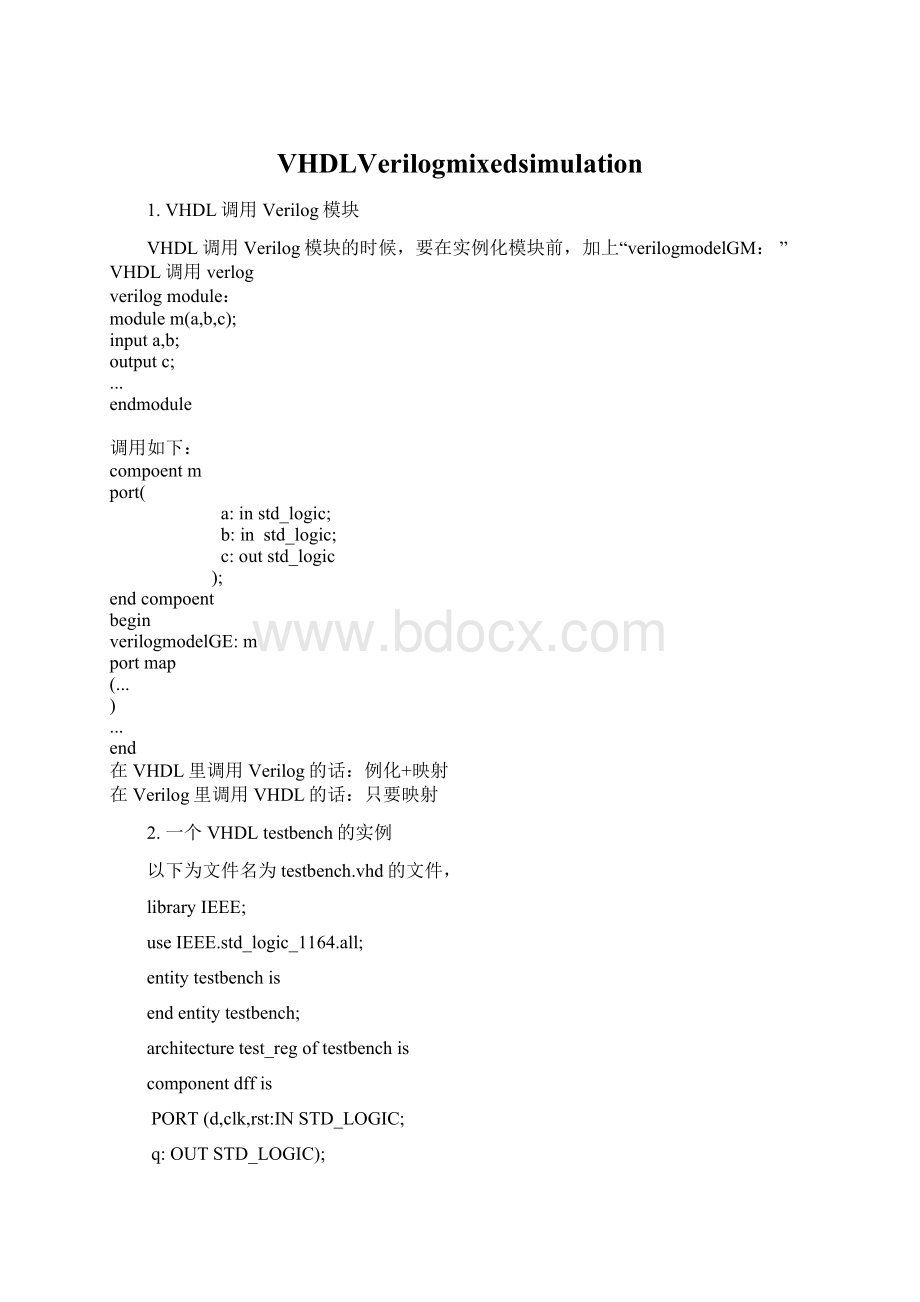VHDLVerilogmixedsimulation.docx
《VHDLVerilogmixedsimulation.docx》由会员分享,可在线阅读,更多相关《VHDLVerilogmixedsimulation.docx(12页珍藏版)》请在冰豆网上搜索。

VHDLVerilogmixedsimulation
1.VHDL调用Verilog模块
VHDL调用Verilog模块的时候,要在实例化模块前,加上“verilogmodelGM:
”
VHDL调用verlog
verilogmodule:
modulem(a,b,c);
inputa,b;
outputc;
...
endmodule
调用如下:
compoentm
port(
a:
instd_logic;
b:
in std_logic;
c:
outstd_logic
);
endcompoent
begin
verilogmodelGE:
m
portmap
(...
)
...
end
在VHDL里调用Verilog的话:
例化+映射
在Verilog里调用VHDL的话:
只要映射
2.一个VHDLtestbench的实例
以下为文件名为testbench.vhd的文件,
libraryIEEE;
useIEEE.std_logic_1164.all;
entitytestbenchis
endentitytestbench;
architecturetest_regoftestbenchis
componentdffis
PORT(d,clk,rst:
INSTD_LOGIC;
q:
OUTSTD_LOGIC);
endcomponent;
signalclock:
std_logic:
='0';
signald,rst:
STD_LOGIC;
signalq:
STD_LOGIC;
constantClockPeriod:
TIME:
=50ns;
begin
UUT:
dffportmap(d=>d,clk=>clock,rst=>rst,q=>q);
generate_clock:
PROCESS(clock)
BEGIN--process
clock<=NOTclockAFTERClockPeriod/2;
ENDPROCESS;
processbegin
d<='0';
rst<='1';
waitfor100ns;
d<='1';
waitfor50ns;
rst<='0';
waitfor50ns;
d<='0';
waitfor100ns;
d<='1';
waitfor50ns;
rst<='1';
wait;
endprocess;
endarchitecturetest_reg;
以下为文件为的异步dff.vhd文件:
LIBRARYieee;
USEieee.std_logic_1164.ALL;
ENTITYdffIS
PORT(d,clk,rst:
INSTD_LOGIC;
q:
OUTSTD_LOGIC);
ENDdff;
ARCHITECTUREbehaviorOFdffIS
BEGIN
PROCESS(rst,clk)
BEGIN
IF(rst='1')THEN
q<='0';
ELSIF(clk'EVENTANDclk='1')THEN
q<=d;
ENDIF;
ENDPROCESS;
ENDbehavior;
以上两个文件放在同一个project下,仿真结果如下图所示:
以下为文件为的同步dff.vhd文件:
LIBRARYieee;
USEieee.std_logic_1164.ALL;
ENTITYdffIS
PORT(d,clk,rst:
INSTD_LOGIC;
q:
OUTSTD_LOGIC);
ENDdff;
ARCHITECTUREbehaviorOFdffIS
BEGIN
PROCESS(rst,clk)
BEGIN
IF(clk'EVENTANDclk='1'')THEN
If(rst=’1’)q<='0';
Elseq<=d;endif;
ENDIF;
ENDPROCESS;
ENDbehavior;
3.VHDL描述D-latch
libraryIEEE;
useieee.numeric_bit.all;
entityD_latchis
port(D,CLK:
inbit;
Q,:
outbit);
endD_latch;
architectureD_latch_insideofD_latchis
begin
process(D,CLK)
begin
ifCLK=‘1’then
Q<=D;
endif;
endprocess;
endD_latch_inside;
4.在时钟上升分支中存在选择语句的情况:
LIBRARYieee;
USEieee.std_logic_1164.ALL;
ENTITYdffIS
PORT(d,clk,rst,cs:
INSTD_LOGIC;
q:
OUTSTD_LOGIC);
ENDdff;
ARCHITECTUREbehaviorOFdffIS
signaltemp:
STD_LOGIC;
BEGIN
PROCESS(rst,clk)
BEGIN
IF(rst='1')THEN
temp<='0';
ELSIF(clk'EVENTANDclk='1')THEN
if(cs='1')thentemp<=d;
elsetemp<=temp;endif;
ENDIF;
q<=temp;
ENDPROCESS;
ENDbehavior;
原理图如下:
实现的器件图如下:
由上面两图可见,在时钟上升沿中出现的选择分支的选择条件cs成为触发器的使能端。
5.VHDL描述D-flip-flop
libraryIEEE;
useieee.numeric_bit.all;
entityD_latchis
port(D,CLK:
inbit;
Q:
outbit);
endD_latch;
architectureD_latch_insideofD_latchis
begin
process(D,CLK)
begin
if(clk'EVENTANDCLK='1')then
--ifCLK='1'then
Q<=D;
endif;
endprocess;
endD_latch_inside;
6.看synplify报告文件
怎么样看懂综合,布线之后的各种报告!
我觉得不是所有的报告都是非看不可的。
根据我的工作经验,只有一部分报告需要仔细关注,然后就是多关注一些Error和Warning信息。
但是大部分warning都无需特别注意。
1.综合完成后应该看得报告:
*.srr这是综合的log文件。
该文件主要搜索“slack”和“latch”即可。
看看有哪些路径的slack是负的,那就意味着该路径需要进一步优化,以达到时序要求。
如果发现综合出来latch,也要判断一下这是否是自己需要的。
作为一般的同步时序电路,latch是要避免的。
2.*.ncf这是P&Rconstraints文件。
是synplify自动生成的供不同techniche(Xilinx,altera...)等器件直接调用的约束文件。
我们通常以ncf为基础,然后做适当修改,保存为UCF文件即可
其他文件我一般不看,而且迄今为止,没有遇到什么问题。
当然遇到具体问题的时候,这些文件也可以作为辅助的资料帮助进一步了解综合后的结果。
对于synplify生成的文件,我给他归类如下
--synthesisresult文件
6srs:
综合后的schematic类型的网表文件,是RTL的结构视图
*.srd:
是综合后的data类型的网表文件。
看不懂:
(
5*.srm:
是综合后的mapped到具体techniche的网表文件。
是个机构视图。
*.srr:
是综合后的report文件,所有的error,warning,timing都在这里了。
5srr*:
这类文件有三个,格式不同内容一致。
是关于area综合结果的report。
--*.edf:
edif格式的网表。
4ncf:
tech相关的约束文件。
我估计是netlistconstraintfile之类名称的缩写。
--*.tlg:
记录了整个综合过程的具体操作。
比如做了何种优化,去掉了哪个比特之类。
PAR应该看得报告。
map报告,看看map结果是否和自己预测的一致,比如useioff是否起了作用,那些iff/off是不是map出来了。
postparstatictiming报告,看看时序是否meet,如果没有,哪些路径出了问题,都要确认。
可以拷贝*.twx出来,然后用ise的accessory中的timinganalyzer仔细分析。
也可以在process窗口中implementatin-->PAR-->PostPARstatictiming-->analyze**timing来看,两者一样。
其他的待续。
。
。
。
IPAR应该看得报告。
map报告,看看map结果是否和自己预测的一致,比如useioff是否起了作用,那些iff/off是不是map出来了。
postparstatictiming报告,看看时序是否meet,如果没有,哪些路径出了问题,都要确认。
可以拷贝*.twx出来,然后用ise的accessory中的timinganalyzer仔细分析。
也可以在process窗口中implementatin-->PAR-->PostPARstatictiming-->analyze**timing来看,两者一样。
7.VHDL输出数据到指定文件
Example1:
usestd.textio.all;
entityiois
endio;
architecturegedragofiois
begin
process
fileOUTFILE:
textisout"C:
\dataout.txt";
variabletemp:
line;
begin
forjin1to9loop
write(temp,j);
writeline(OUTFILE,temp);
endloop;
wait;
endprocess;
endgedrag;
example2
--hello_world.vhdlJustoutputtothescreen
--ThisshouldbeindependentofwhoseVHDLyouuse
--WhenusingsomevendorsGUI,youhavealearningcurve
--UsingportableVHDL,itwillrunonallvendors
--withimplementationsconformingtoIEEEStd.1076-1993
entityhello_worldis--testbench(toplevellike"main")
endentityhello_world;
librarySTD;--youdon'tneedSTD,itisautomatic
libraryIEEE;--butmayneedotherlibraries
useIEEE.std_logic_1164.all;--basiclogictypes
useSTD.textio.all;--basicI/O
useIEEE.std_logic_textio.all;--I/Oforlogictypes
architecturetestofhello_worldis--wheredeclarationsareplaced
subtypeword_32isstd_logic_vector(31downto0);--simplename
signalfour_32:
word_32:
=x"00000004";--justfourinhex
signalcounter:
integer:
=1;--initializedcounter
begin--whereparallelcodeisplaced
my_print:
processis--aprocessisparallel
variablemy_line:
line;--type'line'comesfromtextio
begin
write(my_line,string'("HelloWorld"));--formatting
writeline(output,my_line);--writeto"output"
write(my_line,string'("four_32="));--formatting
hwrite(my_line,four_32);--formattypestd_logic_vectorashex
write(my_line,string'("counter="));
write(my_line,counter);--format'counter'asinteger
writeline(output,my_line);--writetodisplay
write(my_line,string'("attime"));
write(my_line,now);--formattime
writeline(output,my_line);--writetodisplay
wait;
endprocessmy_print;
endarchitecturetest;
--compile/analyzethisfile,thensimulate
--theoutputonthescreenshouldcontainthefollowinglines(without"--")
--HelloWorld
--four_32=00000004counter=1attime0NS
run10000000
#HelloWorld
#four_32=00000004counter=1
#attime0ns
Thewritefunctionisusedtoappendtextinformationattheendofalinevariablewhichisemptywhenthesimulatorisinitialized.Thefunctiontakestwoarguments,thefirstisthenameofthelinetoappendto,andthesecondistheinformationtobeappended.Intheexample,sissetto"Counteroverflow-",andthenthecurrentvalueofcntisconvertedtotextandaddedtotheendofthat.Thewritelinefunctionoutputsthecurrentvalueofalinetothemonitor,andemptiesthelineforre-use.Thefirstargumentofthewritelinefunctionjustindicatesthatthetextshouldbeoutputtothescreen.IfMAX_COUNTwereaconstantequalto15andmorethan15risingedgesoccuronthesignalx,thenthemessagewouldbeprintedonthescreen.
8.一个VHDL中的时钟信号实例
libraryIEEE;
useIEEE.std_logic_1164.all;
entitytestbenchis
endentitytestbench;
architecturetest_regoftestbenchis
componentand2vhdlis
PORT(w11:
INSTD_LOGIC;
w2:
INSTD_LOGIC;
wvec:
OUTSTD_LOGIC_VECTOR(3DOWNTO0));
endcomponent;
signalclock:
std_logic:
='0';
signalw1,w2:
std_logic;
signalwvec:
std_logic_vector(3downto0);
constantClockPeriod:
TIME:
=50ns;
begin
UUT:
and2vhdlportmap(w11=>w1,w2=>w2,wvec=>wvec);
generate_clock:
PROCESS(clock)
BEGIN--process
clock<=NOTclockAFTERClockPeriod/2;
ENDPROCESS;
processbegin
--clock<='1';
w1<='1';
w2<='0';
waitfor200ns;
w1<='1';
w2<='1';
waitfor200ns;
endprocess;
endarchitecturetest_reg;
LIBRARYieee;
USEieee.std_logic_1164.ALL;
ENTITYand2vhdlIS
PORT(w11:
INSTD_LOGIC;
w2:
INSTD_LOGIC;
wvec:
OUTSTD_LOGIC_VECTOR(3DOWNTO0));
ENDand2vhdl;
ARCHITECTUREmyand2OFand2vhdlIS
BEGIN
wvec(0)<=w11ANDw2;
wvec
(1)<=w11ORw2;
wvec
(2)<=w11XORw2;
wvec(3)<=w11XNORw2;
ENDmyand2;